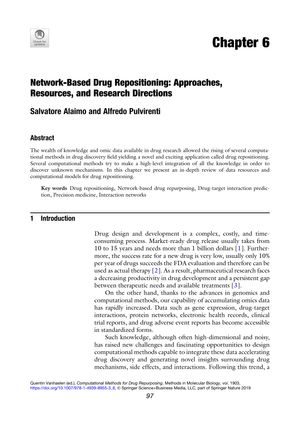Network-Based Drug Repositioning: Approaches, Resources, and Research Directions
December 2018
in “
Methods in molecular biology
”

TLDR The document concludes that computational methods using networks and various data can improve the process of finding new uses for existing drugs.
The 2018 document reviews computational strategies for drug repositioning, which is the process of finding new therapeutic uses for existing drugs. It emphasizes network-based approaches and categorizes them into target-based, side-effect-based, expression-based, and similarity-based methods. The review also discusses the use of omics data and databases like PubChem and DrugBank in developing these strategies. It highlights the importance of drug repositioning for rare diseases and provides examples of successful repositioned drugs, such as Minoxidil for hair loss. Additionally, the document explores the use of gene regulatory networks, metabolic networks, drug interaction networks, and integrated approaches for repositioning. It acknowledges the limitations of these methods, including challenges in making accurate predictions and the risk of false positives and negatives. The paper also describes computational recommendation techniques for predicting novel drug-target interactions, drawing parallels to e-commerce recommendation systems. Despite not providing specific study results, the document outlines the potential of these methods to integrate various data types to enhance the accuracy of drug repositioning predictions.



